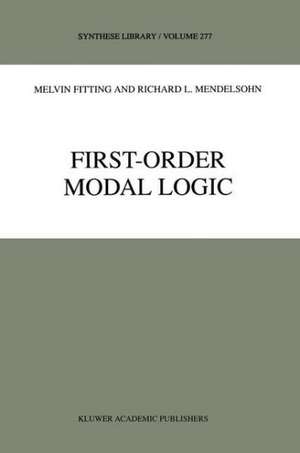First-Order Modal Logic: Synthese Library, cartea 277
Autor M. Fitting, Richard L. Mendelsohnen Limba Engleză Paperback – 31 aug 1999
The book covers quantification itself, including the difference between actualist and possibilist quantifiers; equality, leading to a treatment of Frege's morning star/evening star puzzle; the notion of existence and the logical problems surrounding it; non-rigid constants and function symbols; predicate abstraction, which abstracts a predicate from a formula, in effect providing a scoping function for constants and function symbols, leading to a clarification of ambiguous readings at the heart of several philosophical problems; the distinction between nonexistence and nondesignation; and definite descriptions, borrowing from both Fregean and Russellian paradigms.
Din seria Synthese Library
- 15%
 Preț: 638.43 lei
Preț: 638.43 lei - 18%
 Preț: 989.98 lei
Preț: 989.98 lei - 15%
 Preț: 596.69 lei
Preț: 596.69 lei - 18%
 Preț: 903.93 lei
Preț: 903.93 lei - 15%
 Preț: 586.88 lei
Preț: 586.88 lei - 15%
 Preț: 696.50 lei
Preț: 696.50 lei - 18%
 Preț: 892.90 lei
Preț: 892.90 lei - 15%
 Preț: 643.34 lei
Preț: 643.34 lei -
 Preț: 282.33 lei
Preț: 282.33 lei - 5%
 Preț: 372.19 lei
Preț: 372.19 lei -
 Preț: 443.10 lei
Preț: 443.10 lei - 15%
 Preț: 637.59 lei
Preț: 637.59 lei - 18%
 Preț: 958.88 lei
Preț: 958.88 lei - 15%
 Preț: 642.36 lei
Preț: 642.36 lei - 18%
 Preț: 1230.66 lei
Preț: 1230.66 lei - 15%
 Preț: 642.83 lei
Preț: 642.83 lei - 18%
 Preț: 1000.39 lei
Preț: 1000.39 lei -
 Preț: 389.70 lei
Preț: 389.70 lei - 15%
 Preț: 637.28 lei
Preț: 637.28 lei - 18%
 Preț: 952.26 lei
Preț: 952.26 lei - 18%
 Preț: 1231.32 lei
Preț: 1231.32 lei - 15%
 Preț: 645.96 lei
Preț: 645.96 lei -
 Preț: 395.85 lei
Preț: 395.85 lei -
 Preț: 400.47 lei
Preț: 400.47 lei - 18%
 Preț: 1225.48 lei
Preț: 1225.48 lei - 15%
 Preț: 638.89 lei
Preț: 638.89 lei - 18%
 Preț: 1232.09 lei
Preț: 1232.09 lei -
 Preț: 380.45 lei
Preț: 380.45 lei -
 Preț: 394.87 lei
Preț: 394.87 lei - 15%
 Preț: 640.37 lei
Preț: 640.37 lei - 15%
 Preț: 639.08 lei
Preț: 639.08 lei -
 Preț: 381.98 lei
Preț: 381.98 lei - 15%
 Preț: 643.00 lei
Preț: 643.00 lei - 15%
 Preț: 672.29 lei
Preț: 672.29 lei
Preț: 1380.78 lei
Preț vechi: 1683.87 lei
-18% Nou
Puncte Express: 2071
Preț estimativ în valută:
264.25€ • 274.86$ • 218.15£
264.25€ • 274.86$ • 218.15£
Carte tipărită la comandă
Livrare economică 15-29 aprilie
Preluare comenzi: 021 569.72.76
Specificații
ISBN-13: 9780792353355
ISBN-10: 0792353358
Pagini: 292
Ilustrații: XII, 292 p.
Dimensiuni: 160 x 240 x 18 mm
Greutate: 0.44 kg
Ediția:Softcover reprint of the original 1st ed. 1998
Editura: SPRINGER NETHERLANDS
Colecția Springer
Seria Synthese Library
Locul publicării:Dordrecht, Netherlands
ISBN-10: 0792353358
Pagini: 292
Ilustrații: XII, 292 p.
Dimensiuni: 160 x 240 x 18 mm
Greutate: 0.44 kg
Ediția:Softcover reprint of the original 1st ed. 1998
Editura: SPRINGER NETHERLANDS
Colecția Springer
Seria Synthese Library
Locul publicării:Dordrecht, Netherlands
Public țintă
ResearchCuprins
One/Propositional Modal Logic.- 1.1 What is a Modal?.- 1.2 Can There Be a Modal Logic?.- 1.3 What Are The Formulas?.- 1.4 Aristotle’s Modal Square.- 1.5 Informal Interpretations.- 1.6 What Are the Models?.- 1.7 Examples.- 1.8 Some Important Logics.- 1.9 Logical Consequence.- 1.10 Temporal Logic.- 1.11 Epistemic Logic.- 1.12 Historical Highlights.- Two/Tableau Proof Systems.- 2.1 What Is a Proof.- 2.2 Tableaus.- 2.3 More Tableau Systems.- 2.4 Logical Consequence and Tableaus.- 2.5 Tableaus Work.- Three/Axiom Systems.- 3.1 What Is an Axiomatic Proof.- 3.2 More Axiom Systems.- 3.3 Logical Consequence, Axiomatically.- 3.4 Axiom Systems Work Too.- Four/Quantified Modal Logic.- 4.1 First-Order Formulas.- 4.2 An Informal Introduction.- 4.3 Necessity De Re and De Dicto.- 4.4 Is Quantified Modal Logic Possible?.- 4.5 What the Quantifiers Quantify Over.- 4.6 Constant Domain Models.- 4.7 Varying Domain Models.- 4.8 Different Media, Same Message.- 4.9 Barcan and Converse Barcan Formulas.- Five/First-Order Tableaus.- 5.1 Constant Domain Tableaus.- 5.2 Varying Domain Tableaus.- 5.3 Tableaus Still Work.- Six/First-Order Axiom Systems.- 6.1 A Classical First-Order Axiom System.- 6.2 Varying Domain Modal Axiom Systems.- 6.3 Constant Domain Systems.- 6.4 Miscellany.- Seven/Equality.- 7.1 Classical Background.- 7.2 Frege’s Puzzle.- 7.3 The Indiscernibility of Identicals.- 7.4 The Formal Details.- 7.5 Tableau Equality Rules.- 7.6 Tableau Soundness and Completeness.- 7.7 An Example.- Eight/Existence and Actualist Quantification.- 8.1 To Be.- 8.2 Tableau Proofs.- 8.3 The Paradox of NonBeing.- 8.4 Deflationists.- 8.5 Parmenides’ Principle.- 8.6 Inflationists.- 8.7 Unactualized Possibles.- 8.8 Barcan and Converse Barcan, Again.- 8.9 Using Validities in Tableaus.- 8.10 On Symmetry.-Nine/Terms and Predicate Abstraction.- 9.1 Why constants should not be constant.- 9.2 Scope.- 9.3 Predicate Abstraction.- 9.4 Abstraction in the Concrete.- 9.5 Reading Predicate Abstracts.- Ten/Abstraction Continued.- 10.1 Equality.- 10.2 Rigidity.- 10.3 A Dynamic Logic Example.- 10.4 Rigid Designators.- 10.5 Existence.- 10.6 Tableau Rules, Varying Domain.- 10.7 Tableau Rules, Constant Domain.- Eleven/Designation.- 11.1 The Formal Machinery.- 11.2 Designation and Existence.- 11.3 Existence and Designation.- 11.4 Fiction.- 11.5 Tableau Rules.- Twelve/Definite Descriptions.- 12.1 Notation.- 12.2 Two Theories of Descriptions.- 12.3 The Semantics of Definite Descriptions.- 12.4 Some Examples.- 12.5 Hintikka’s Schema and Variations.- 12.6 Varying Domain Tableaus.- 12.7 Russell’s Approach.- 12.8 Possibilist Quantifiers.- References.
Recenzii
"This Text is an excellent and most useful volume. It is pitched correctly: the exercises are just right... It sets a high standard for anything following. It is to be highly recommended."
(Bulletin of Symbolic Logic, 8:3)
(Bulletin of Symbolic Logic, 8:3)
